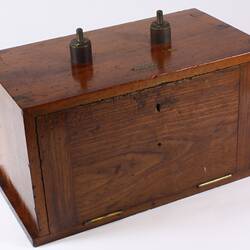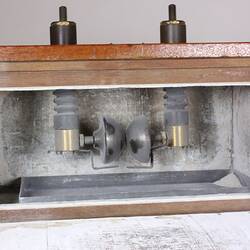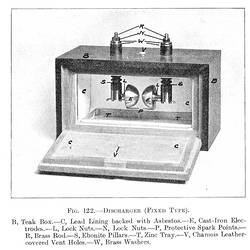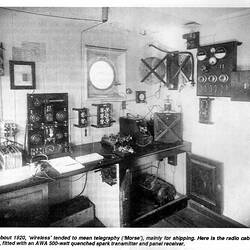Summary
Marconi discharger, fixed gap type. Used with small radio transmitters. Made by the Marconi Wireless Telegraph Co., London, England.
Discharger is the term used to describe the device in which a spark jumps a gap.
The process by which a signal is transmitted begins with the charging of a capacitor by the output from an alternator stepped up to a high voltage by transformer. In smaller transmitters, the capacitor was charged from an induction coil.
When the capacitor is charged to a high enough voltage to break down the spark gap, it discharges into an inductor (a coil). The energy stored in the capacitor as an electric field, flows into the inductor where it is stored as a magnetic field. The flow then reverses producing an oscillation, which continues until all the energy is lost by radiation and heat.
The fixed gap was the first type of discharger used by Marconi; others introduced the quenched gap. Marconi replaced the fixed gap with the rotary gap discharger. These improved the efficiency of spark transmitters.
The spark gap is enclosed in a lead lined wooden box to reduce the considerable noise produced during operation; the spark gap was often kept in a ship's radio room. The box is also lined with asbestos to protect the wood from the heat of the spark.
Physical Description
Dark brown polished wooden box 1with two insulated brass connectors on top. A door with lock (no key with object) allows access to inside. The internal sides are powdery whitish grey in colour. There is a unattached grey metal tray on the the base, with some greyish powder in the tray. Hanging from the top are two hemispherical elctrodes; the curved surfaces facing each other acrross a gap. The electrodes are connected through the top of the box to the two external connectors.
More Information
-
Collecting Areas
-
Acquisition Information
Donation from Amalgamated Wireless (Australasia) Ltd., 29 Dec 1924
-
Manufacturer
Marconi Wireless Telgraph Co. Ltd, London, Great Britain, 1900-1920
-
Inscriptions
Metal plate on external top of box: MARCONI'S WIRELESS / TELEGRAPH CO LTD / MO 29465 LONDON
-
Brand Names
-
Classification
-
Category
-
Discipline
-
Type of item
-
Overall Dimensions
515 mm (Length), 275 mm (Width), 330 mm (Height)
-
Keywords





